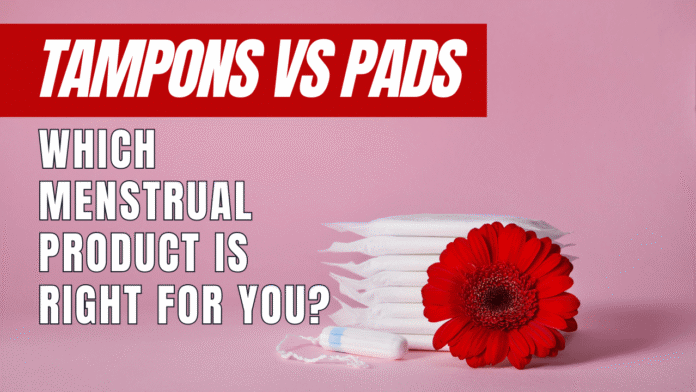Choosing between tampons and pads can be daunting for many individuals, particularly for those new to menstruation or looking to switch products. The debate about tampons vs pads centers around various factors, such as comfort, convenience, and health considerations. Each product has its unique set of advantages and potential drawbacks, making it essential to understand their respective features before making a decision. In this blog, we’ll break down the basics of tampons and pads, discuss their health and environmental implications, and provide practical tips to help you find the perfect fit. Let’s get started on this essential topic.
Understanding the Basics
What Are Tampons and How Do They Work?
Tampons are small, cylindrical products designed to be inserted into the vagina to absorb menstrual blood directly. Made from cotton, rayon, or a blend of both, tampons expand as they soak up fluid, conforming to the body’s shape.
Different types of tampons are available, including those with applicators and those without. Applicator tampons come in plastic or cardboard varieties, making insertion easier for some users. Non-applicator tampons require manual insertion but are often preferred for their reduced environmental impact.
What Are Pads and How Do They Work?
Pads, also known as sanitary napkins, are absorbent products worn outside the body and adhered to the inside underwear. Made from layers of absorbent material, pads come in various sizes and thicknesses to cater to different flow levels.
Pads are straightforward and do not require insertion, making them a popular choice for many. They have adhesive strips that keep them in place; some have wings to prevent leakage.
Pros and Cons of Tampons
Pros:
- Discreet and invisible under clothing.
- Convenient for physical activities, including swimming.
- Offers up to eight hours of protection.
Cons:
- Risk of Toxic Shock Syndrome (TSS) with prolonged use.
- Can be uncomfortable for some users.
- Requires insertion, which may be challenging for beginners.
Pros and Cons of Pads
Pros:
- Easy to use and change.
- No risk of TSS.
- Available in various sizes and absorbencies.
Cons:
- Visible under tight clothing.
- Can feel bulky and uncomfortable.
- May shift out of place during physical activities.
Health and Environmental Considerations
Impact on the Environment
Both tampons and pads have drawbacks when it comes to environmental impact. Pads contribute to landfill waste due to their plastic components, which are not biodegradable. Tampons, especially those with plastic applicators, also contribute to environmental waste.
However, eco-friendly alternatives are available. Organic cotton tampons and reusable menstrual pads are becoming popular among environmentally conscious consumers. These products offer a sustainable option without compromising on effectiveness.
Health Implications
Health considerations are crucial when choosing between tampons and pads. Tampons carry a risk of Toxic Shock Syndrome (TSS), a rare but serious condition caused by bacterial toxins. To minimize this risk, tampons must be changed every 4 to 8 hours and used with the lowest absorbency possible.
Pads, on the other hand, do not pose a TSS risk. However, if not changed frequently, they can cause skin irritation or rashes, especially in hot and humid conditions. Practicing good hygiene and choosing products that suit your skin type is important.
Lifestyle and Convenience Factors
Managing Different Flow Levels
Both tampons and pads come in various absorbencies to manage different flow levels. Tampons are available in light, regular, super, and super plus absorbencies, making them versatile for any stage of your period.
Pads also offer a range of options, from panty liners for light days to overnight pads designed for heavy flow. Matching the product’s absorbency to your flow ensures maximum comfort and protection.
Effect on Physical Activities
Tampons are often the preferred choice for those with an active lifestyle. They are discreet, stay in place, and allow for a full range of motion, making them ideal for sports and swimming.
Pads can be cumbersome during physical activities. However, some brands offer slim, ultra-absorbent pads designed for active use. It’s a matter of personal preference and finding what works best for your body and routine.
Making the Right Choice Between Tampons Vs Pads
1) Consider Your Lifestyle and Preferences
Choosing between tampons and pads ultimately boils down to personal preference, lifestyle, and comfort. Both products are equally effective in managing periods; it’s a matter of finding what works for you.
2) Be Mindful of Health and Environmental Implications
It is crucial to consider the health implications of both products, particularly the risk of TSS associated with tampon use. Additionally, opting for eco-friendly alternatives can help reduce your environmental impact.
3) Experiment with Different Brands and Products
Try out different brands and types of tampons and pads to find what fits best for your body. It may take some trial and error, but don’t be afraid to explore different options until you find the perfect fit.
4) Seek Advice from a Healthcare Professional
If you have any concerns or questions about using tampons or pads, don’t hesitate to consult with your healthcare provider. They can offer personalized advice and recommendations based on your specific needs.
You might be interested in:How to Clean Menstrual Cup for a Healthy Cycle!
Conclusion
Ultimately, the decision between tampons and pads is a personal one. Both products have their unique features and considerations, making them suitable for different individuals and situations. By understanding the difference between tampons vs pads, considering your health and lifestyle needs, and being mindful of environmental impact, you can make an informed choice that suits your body and preferences. Remember to prioritize comfort and convenience above all else, as managing periods should never be a source of discomfort or inconvenience. So, whether you prefer tampons or pads, know that both options are effective and can help you easily navigate your period.
